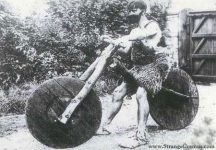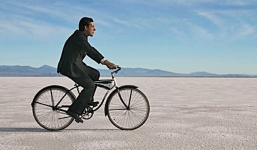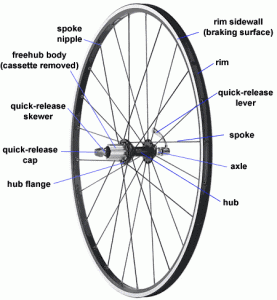Bike wheels

The invention of the wheel revolutionized the caveman's daily hunting and gathering commute. Suddenly cave people were back in their dwelling well before sunset, which left plenty of time for other activities like domesticating dogs, discovering fire, and throwing cave parties with the neighbors.

Bicycle - a vehicle composed of two wheels held in a frame one behind the other, propelled by pedals and steered with handlebars attached to the front wheel.

Let's get things rolling.
Bike wheels ("wheelsets" in pairs) start with the hub. This is the axle and bearing in the middle of the wheel, to which spokes can be attached on what is called the hub shell. The axle runs through the hub and supports the frame dropouts. Extending from the hub in the center are the spokes evenly supporting the rim under tension, connected by spoke nipples. On the outside of the rim sits the rubber tire making contact with the riding surface. Adjustments in spoke tension have huge impacts on wheel geometry, durability, and overall riding performance

Wheels are a manufacturing art form of specialized aerodynamic components made from strong and lightweight materials. Different types of bikes utilize different wheel structures and sizes.
Amazon.com has some low-budget options in the $50 range, but they will be mass-produced aluminum and will not be as lightweight or strong as the carbon fiber wheels. Wheelsets for both road bikes (700c) and mountain bikes (26in) will be priced evenly as the value increases. The most touted carbon fiber wheelsets are going online in excess of $5,000! If you are in an emergency or on a serious budget, aluminum wheels will do the job just fine, but if you're even thinking about getting serious with your cycling, we have some carbon fiber wheels around $250.

Keep in mind that you can follow a step by step process to assemble your own wheel, from the hub to the spokes to the rim. It saves a guy a lot of hard-earned dollars, and there are plenty of great tutorials out there to walk you through it. Building a wheel saves a lot of money and can give a sense of pride that you build what you ride, ride what you build. However if you don't like the thought of putting your life in your own hands, that's ok too.

Repairing bent wheels (called truing) can be one of the most difficult tasks one can do on a bicycle. If the rim is bent, or it's noticed that it is coming close to touching a brake pad, your wheel probably needs to be trued. Bringing the rim back into balance takes attention to detail that's mostly learned from building wheels in the first place. Patience is key, so if you're ready to bring that wheel back from the dead, here are some tips:

- Get a truing stand - the wheel can sometimes be trued while the bike is flipped over, but it just simplifies working on the wheel. Truing stands help notice slight imperfections that would otherwise be overlooked still in the frame dropouts.
Take a deep breath and don't rush anything. If there is a small flaw in the rim, you can find it by shining a light on the rim. In the reflection you will be able to find where the smooth stops and the trouble starts. Before messing with any spokes, try to hit the rim lightly with a rubber hammer to flatten the bump. Remember that you are working with very light metals, and overcorrecting can give more headaches than you might be ready for. Be gentle.


When corrections are made to a small part of the rim, it affects the geometry of the whole thing. Work around the rim making even, small turns of the spoke nipples. Constantly check that spoke tension is even with your fingers. They should bend only under significant pressure. Broken spokes will be apparent.


One thing to consider is that if the rim is severely dented, simply tightening loose spokes will only further deform the rim. Use a hammer to get the rim as close to round as possible before tightening spoke nipples. When a loose spoke is found, sometimes it is helpful to check the adjacent spokes at the same time. Covering more spokes makes a more uniform, round area of the rim.
And finally: don't be a hero. If you have made many adjustments at very small increments and the wheel just doesn't seem to come into balance, take it to a professional. Solving the problems early and without too many adjustments will keep from further weakening the rim.
Wheels (and their diameters) can be put into categories based on their use:
For road and track bikes, lightweight and aerodynamic wheels are critical for high speeds, and large diameters allow for less rolling resistance (a fancy physics term for friction). The normal diameter for road bike wheelsets is 622mm or 29in.
Mountain bikes need more rigidity and bulk strength. Therefore smaller diameters and thicker frames handle better the impacts of rumbling and tumbling down the trail. The most common mountain bike tire diameter is 559mm or 26in.
Different wheel and tire standards arose throughout the world in the early 20th century. Thankfully, programs like the International Organization for Standardization (ISO) and the European Tyre and Rim Technical Organization (ETRTO) developed definitive sizing scales and measuring procedures. This eliminated a lot of confusion in wheel and tire compatibility worldwide. The ISO system uses two numbers. the first is the outside width of the tire or rim in millimeters, while the second number is the most critical. It's the diameter of the bead seat of the rim (BSD) in millimeters. If this number matches, the tire will fit onto the rim.
If the tire is too narrow for the rim, there's a higher risk of damaging the wheel from debris on the road. Likewise, if the tire is too wide for the rim, there will be increased wear on the sidewalls of the tire and greater risk of a blowout.


The following sizing table was roughly transcribed from Sheldon Brown:
Common Tire Sizes and their ISO Equivalents |
||
| Fractional (inches | ISO | Applications |
| 29 inch | 622mm | Most common width of road bike wheels |
| 28 x 1 1/2 | 635mm, 622mm | English, Dutch, Chinese, Indian Rod-brake roadsters (Also marked F10, F25, 700 B), rare Canadian designation for the F13 |
| 28 x 1 5/8 x 1 1/4 | 622mm | Northern European designations for 622mm (700c) tires |
| 27 x anything | 630mm | Older road bikes |
| 26 x 1 (650c) | 571mm | Triathlon, time trial, smaller road bikes |
| 26 x 1 1/4 | 597mm | Older British sport and club bikes |
| 26 x 1 3/8 (S-6) | 597mm | Schwinn "lightweights" |
| 26 x 1 3/8 (E.A.3) | 590mm | Most English 3-speeds, department store or juvenile 10 speeds |
| 26 x 1 1/2 (650B) | 584mm | French utility, tandem and loaded-touring bikes, and very few Raleigh (US) and Schwinn mountain bikes |
| 26 x 1 3/4 (S-7) | 571mm | Schwinn cruisers, mountain bikes |
| 26 x 1 1/8 | 571mm | Mountain bikes |
| 26 x 1 1/4 | 559 | Most common diameter of mountain bike wheels |
| 24 x 1 | 520mm | High performance wheels for smaller rides |
| 24 x 1 1/8 | 520 or 540mm | Caveat emptor |
| 24 x 1 1/4 | 547mm | British or Schwinn juvenile |
| 24 x 1 3/8 (S-5) | 547mm | Schwinn juvenile lightweights |
| 24 x 1 3/8 (E-5) | 540mm | British juvenile |
| 20 x 1 1/8
20 x 1 1/4 20 x 1 3/8 |
451mm | Juvenile lightweights, some light BMX bikes, and some recumbents |
| 20 x 1 3/4 | 419mm | Schwinn juvenile |
| 17 x 1 1/4 | 369mm | Alex Moulton AM series |
| 16 x 1 3/8 | 349mm | Older Moulton, recumbent front, juvenile |
| 16 x 1 3/8 | 335mm | Polish juvenile |
| 12 1/2 x anything | 203mm | Juvenile, scooters |